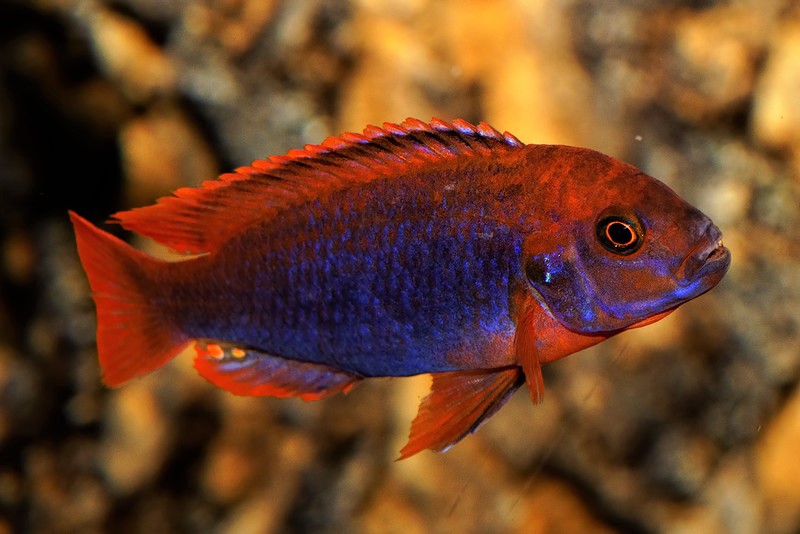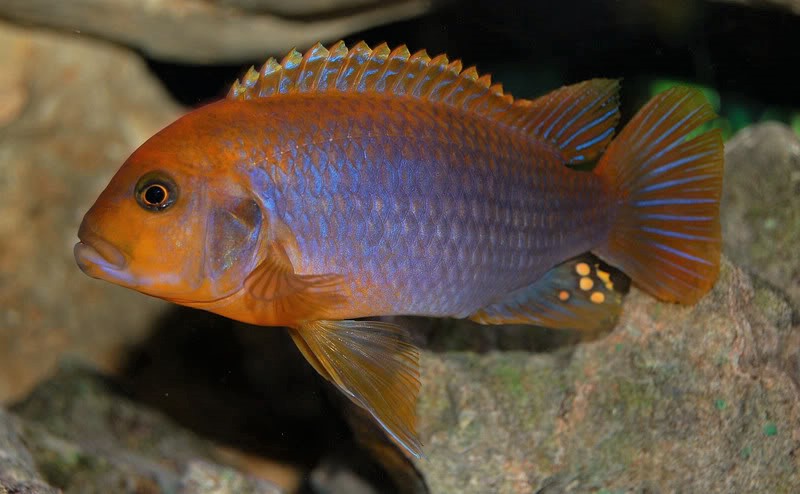Rusty Cichlid is so bright that they can inadvertently confuse marine life. This quality is used by some aquarists to create a pseudo – sea – a freshwater aquarium that looks like a coral reef. Agile, colorful fish will definitely attract attention for a long time. Spenger’s Iodotropheus is one of the notable cichlids that will find its place in a species aquarium.

Few Details About Rusty Cichlid
Iodotropheus Sprengerae(Latin Iodotropheus sprengerae, English Rusty Cichlid) is sometimes called mbuna lavender, rusty cichlid, or affectionately “iodic”. This fish is representative of the Cichlid family, the Mbuna group, and the Iodotropheus genus, numbering three species. In nature, it is endemic to the southern part of Lake Malawi. It lives mainly in shallow waters near coastal rocky areas.
Rusty Cichlid is a medium-sized fish – its length does not exceed 10 cm. In captivity, as a rule, it is slightly smaller – up to 7.5 cm.
This cichlid was nicknamed rusty for its unusual color, which really resembles rust: the middle of the body is blue with a purple tint, but the body outline is red, similar to the color of iodine – another explanation for the origin of another name – iodotropheus.
In the aquarium, this mobile fish inhabits the bottom and middle layers, often dig through the ground, drags pebbles and shells, in general, tries to equip the dwelling for itself. Some breeders note the intelligence of pets – they meet the owner, beg for food, willingly eat from their hands.
Related : Pictus Catfish Care Guide
Aquarium Conditions For Rust Cichlid
Rusty Cichlid buna lavender is easy to care for and can be maintained by any amateur aquarist who dares to “jar with Malawians “. Although the fish itself is hardy, like other cichlids, it “puts forward” certain requirements for the place of residence, on which the beauty of its appearance depends:
- A couple of fish will need an aquarium of 80 liters or more. If you plan to move neighbors or keep a group, then the volumes must be increased.
- Hiding places is a must for an aquarium with Malawian cichlids. For these purposes, you can use inverted clay pots, grottoes, and mangrove snags, which will divide the space into zones.
- Overcrowding leads to constant stress, quarrelsomeness, and fights, which can be tragic.
- Due to the tendency to break the soil and pulling out vegetation, you will have to abandon greenery or choose rigid-leaved plants planted in a pot.
- Sand or small pebbles you can use as soil.
Recommended water parameters:
- Temperature: 25-29 ° C;
- Acidity: 7.5–8.8 pH. Dislikes sour water and can get sick in it;
- Hardness: 10–25 ° dGH;
- Filtration and aeration are in requirements
- Weekly water changes 25% of the total.
Feeding
In nature, it is an omnivorous fish, but plant food predominates in its diet. In captivity, it actively eats dry, live, and frozen food: brine shrimp, tubifex, bloodworms, koretra.
Particular attention should pay to plant feeding by the owner. The owner can please his “iodics” with zucchini, cucumbers, cabbage, salad, or dry food with the addition of spirulina. To prevent obesity, arrange fasting days for adult fish once a week.

Breeding
These fish are polygamous, and their sexual maturity occurs when the body length is 4 cm. If the volume of the aquarium allows, you can keep a group of individuals – one male and several females, they will all breed together.
Distinguishing the sex of fish is a difficult but doable task. Males are brighter, more massive, their dorsal and anal fins are sharpened, and caviar spots on the anal fin are present in large numbers and are clearly expressed.
The aquarium is lined with flat stones and open areas of sand – all of these materials will serve as a substrate for spawning. The temperature should be 25-27 ° С, acidity – 8.0-8.5 pH. 2 weeks before spawning, producers are actively fed high-protein live or frozen food to obtain high-quality sex products.
The male occupies a vast territory with a flat stone and begins to demonstrate to the passing females all the beauty of its colors with trembling movements. If the female is ready for breeding, she will show interest in his courtship, and together they will go to the spawning grounds.
The female lays eggs in small portions, after which she immediately picks them off. She takes bright spots on the anal fin of the male for eggs that she forgot to collect. The female begins to pull on the male’s anal fin, prompting him to release milk, which gets into her mouth and fertilizes the eggs. The process is repeated several times until all the eggs are swept out and placed in the female’s mouth. The fertility of rusty cichlids, as a rule, is 5-60 eggs.
More About Breeding Rusty Cichlid
The female bears eggs in her mouth for 2-3 weeks. All this time she does not eat anything, and her goiter looks puffy. Due to stress, she can prematurely spit out the offspring or eat it, so if there are a lot of cocky neighbors in the aquarium, then it is recommended to plant the female
Sometimes, after the incubation period, the female may refuse to release the fry. This is fraught with dire consequences for both her and her offspring. As a rule, fully formed fry can be seen in her mouth, trying to get out, but immediately being sucked back by the female. In this case, it is recommended to help the “woman in labor”. To do this, use a basin of water and a toothpick, with which the female’s jaw is folded back. As a rule, the fry swims out on their own. At this moment, the fish should hold tight.
In some cases, aquarists “shake out” the producers ahead of schedule, in order to pick up the larvae and raise them on their own. In this case, instead of a toothpick, a tube is used, with which the juveniles are washed out of the female’s oral cavity.

If the incubation is successful, and the babies have grown up, the female spits out the offspring, which immediately begins to feed on its own. During this time, feed them with brine shrimp nauplii or finely crushed flakes containing spirulina. Juveniles grow rapidly and become sexually mature within a few months.
For the safety of the young, we recommend to transplant it from adults into a nursery aquarium.
Compatibility
This wonderful dwarf African cichlid has a restrained temperament, and its size allows it to be kept in small containers. Neighbors need to be selected wisely because this fish cannot always repel especially aggressive cichlids.
Intraspecific aggression is worth mentioning separately. Better to keep a pair or harem with one male and several females. The neighborhood of several males is possible only with large volumes of the aquarium.
The best option for keeping is with other Malawian cichlids from the Mbuna group.

Based on the foregoing, good neighbors for Rusty Cichlid will be:
- Rusty Cichlid other groups: YELLOW, auratus, Lombardo, demasoni etc
- Barbs (except for peaceful ones)
- Kalamoichts and polypters
- Labeo
- Metinnis
- Battles
- Large chain mail catfish
- Cichlazomas.
Neighborhood that should not be there:
- Viviparous
- Small haracin (neons, tetras, etc.)
- Goldfish
- Cockerels
- Apistograms
- Scalars
- Snails and shrimps.




